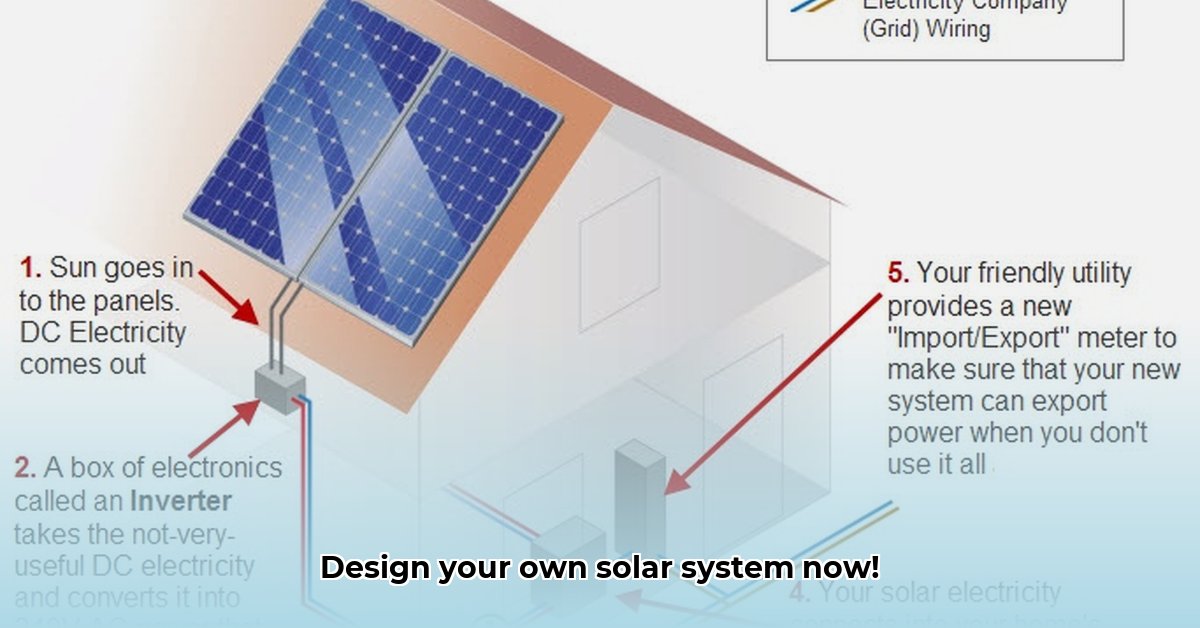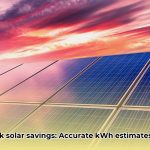Want to go solar but feel lost in the technical jargon? Don’t worry, you don’t need to be an engineer to understand how solar panels work. This guide will show you exactly how solar energy diagrams work, making it easy to pick the right system for your home. We’ll break down the diagrams step-by-step, explaining everything in plain English, so you can feel confident making informed decisions about your solar investment. To learn about solar panel energy production, check out this helpful resource: solar panel output. Get ready to understand solar power – and how to get the most out of it!
Solar Energy Diagrams: Your Roadmap to Energy Independence
Thinking about going solar? Understanding solar energy diagrams is your first step towards harnessing the sun’s power for your home, giving you energy independence. These aren’t just complicated drawings; they’re roadmaps to a cleaner, cheaper energy future. They illustrate the flow of energy and the relationships between components, making it easier to visualize and plan your solar installation. Let’s break down what they mean and how they can help you in residential solar panel systems.
Decoding the Key Components of Your Solar Power System
A typical solar energy diagram shows how different parts of your solar setup work together. Understanding these components is crucial for making informed decisions. Let’s meet the key players:
-
Photovoltaic (PV) Cells: These are the fundamental building blocks of solar panels, converting sunlight directly into electricity through the photovoltaic effect. They’re like tiny solar power plants, each generating a small amount of DC electricity. Diagrams show these cells grouped within the solar panels. Each cell contains a semiconductor material, typically silicon, that facilitates the flow of electrons when exposed to photons from sunlight.
-
Solar Panels: These aren’t single cells; they’re teams of PV cells wired together and encapsulated in a protective layer. This increases the voltage output and generates more power for your home, business, or farm. Solar panels are rated by their wattage output under standard test conditions (STC). You’ll see them clearly arranged in a solar diagram.
-
Inverters: The AC/DC Translators: Your home uses alternating current (AC) electricity, but solar panels produce direct current (DC). The inverter is the translator, converting that DC electricity into the AC your appliances need. It’s the system’s communications hub, and your diagram will show exactly where it sits. Inverters also perform critical functions such as Maximum Power Point Tracking (MPPT) to optimize energy production and grid synchronization to ensure safe and efficient power flow.
-
Batteries (Optional): The Energy Storage Solution: Batteries aren’t always part of the system, but they’re super helpful, especially for off-grid or backup power systems. They store extra energy produced during sunny periods for use later, like at night or during a power outage. These are the system’s savings account, and if included, diagrams will show their size and connection. Battery capacity is measured in kilowatt-hours (kWh) and determines how much energy can be stored.
-
Charge Controller (if using batteries): This device regulates the voltage and current flowing to the batteries, preventing overcharging and extending their lifespan. It’s essential for maintaining battery health and optimizing performance.
-
Grid Tie: Connection to the Utility Grid: Most home solar systems connect to the main power grid. This lets you use power from the grid when your system isn’t producing enough and even sell any extra power back to the utility company through net metering. Your diagram shows this critical link. This interconnection requires specific equipment and approvals from your utility company.
-
Disconnect Switches: These are safety devices that allow you to manually disconnect the solar system from the grid or the batteries for maintenance or emergency situations. These switches are often required by local codes and are important for safety.
-
Monitoring System: Many modern solar systems include a monitoring system that tracks the performance of the panels, inverter, and batteries. This allows you to see how much energy you’re producing, identify any problems, and optimize the system’s performance.
Reading Your Solar Energy Diagram: A Detailed Guide
Let’s learn to read these diagrams like a map, so you can grasp the inner workings of photovoltaic technology:
-
Identify the Key Parts: First, find the PV cells (those tiny powerhouses), the panels (their teams), the inverter (the translator), the battery (if there is one – the savings account), the charge controller (if applicable), and the connection point to the power grid. These symbols are pretty standard across most diagrams, though they can vary slightly. Look for a legend or key that explains the symbols used in your specific diagram.
-
Trace the Energy Flow: Next, trace the lines or arrows. They show how the electricity flows from the solar panels, through the inverter (and charge controller if present), to your house and/or back into the power grid. It’s like following a river’s path. Pay attention to the direction of the arrows to understand the flow of energy.
-
Understand the Power Numbers: Pay close attention to the power ratings (usually in watts or kilowatts) for each component. This tells you how much electricity each part can handle. This is crucial for making sure your system works correctly, so check your diagram carefully for these crucial numbers. The power ratings will help you determine if the components are properly sized for your energy needs.
-
Safety Features: Many diagrams also show safety features like circuit breakers, fuses, and disconnect switches. These are like safety valves, protecting your system and your home from problems. Understand their roles within the system. These are essential for preventing electrical hazards and ensuring the safety of your solar installation.
-
Panel Positioning: The direction and angle of your solar panels influence how much power you get, like angling a satellite dish. Your diagram will show the ideal orientation based on your location and the sun’s path. This information is critical for maximizing energy production.
Optimizing Solar Performance: Practical Steps for Homeowners
For homeowners, understanding your solar energy diagram is essential for smart decisions about solar panel maintenance and maximizing energy production:
-
Sunlight Assessment: Use online tools (like Google’s Project Sunroof) and your diagram to pinpoint the sunniest spots on your property. The more sun, the more power! Consider factors like shading from trees or buildings at different times of the day and year. This is key for placing your panels effectively.
-
Selecting a Reputable Installer: It’s crucial to find a trustworthy installer. Get several quotes, verify their licenses and insurance, and make sure they understand solar diagrams as well as all the other aspects of the job. Ask for references and check online reviews to assess their reputation.
-
Evaluating Financing Options: Check out loans, leases, or Power Purchase Agreements (PPAs) to find the best way to pay for your solar system. Each option has different implications for your long-term costs and ownership.
-
Leveraging Government Incentives: Look for local, state, and federal tax credits and rebates to reduce your costs. These incentives can significantly reduce the payback period of your solar investment.
-
Regular Monitoring: Use your system’s monitoring system to track its performance and identify any potential problems early on. This will help you maximize energy production and ensure the longevity of your system.
Types of Solar Energy Diagrams: A Quick Overview
There are several types of diagrams, each with a specific purpose. Understanding the differences will help you interpret the information effectively:
-
Single-Line Diagrams: These are simplified overviews, showing the main components and the flow of electricity in a single line. They’re useful for understanding the basic system configuration.
-
Schematic Diagrams: These are more detailed, showing all the connections between the components, including wiring and circuit protection devices. They’re helpful for troubleshooting and understanding the electrical details of the system.
-
P&ID Diagrams (Piping and Instrumentation Diagrams): These highly detailed diagrams are usually used for larger solar power plants, showing every single piece of equipment, its connections, and instrumentation.
Understanding solar energy diagrams is a major step toward cleaner energy, helping you visualize the solar power conversion. These diagrams are essential tools for designing, troubleshooting, and generally understanding your solar system. Ask your installer for a clear and comprehensive diagram before making a decision. They’re your pathway to understanding and using solar power in your solar project.
How to Compare Different Home Solar Panel System Costs and Long-Term ROI
Visualizing your solar energy system is key to understanding its efficiency and financial implications, especially within the context of renewable energy solutions. Diagrams help you grasp how individual components work together, from the sun’s rays to your electricity bill. Understanding cost and ROI (return on investment) is crucial to making the right decision. Let’s dive in!
Decoding the Solar System Diagram: A Step-by-Step Guide
Solar panel systems may seem complicated, but understanding the basics is easier than you think. A typical system includes several key components for solar power generation:
-
Solar Panels (PV Arrays): These are the workhorses, converting sunlight into direct current (DC) electricity via the photovoltaic effect. Think of them as nature’s batteries, constantly recharging. The more panels, the more power you generate. The panel array size depends on your energy needs and available roof space.
-
Inverter: This crucial component transforms the DC electricity from the panels into alternating current (AC) electricity, the type your home uses. It’s like a translator, making solar energy compatible with your appliances. There are
- Hydro Extrusions USA Leads North American Aluminum Profile Solutions - December 28, 2025
- Hydro North America Leads Aluminum Extrusion Solutions Across Diverse Industries - December 27, 2025
- Hydro Extrusion North America Provides Custom Solutions Across Diverse - December 26, 2025
















